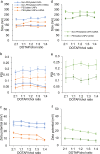Optimization of DOTAP/chol Cationic Lipid Nanoparticles for mRNA, pDNA, and Oligonucleotide Delivery
- PMID: 35534697
- PMCID: PMC9084260
- DOI: 10.1208/s12249-022-02294-w
Optimization of DOTAP/chol Cationic Lipid Nanoparticles for mRNA, pDNA, and Oligonucleotide Delivery
Abstract
Lipid nanoparticles (LNPs) can be used as delivery vehicles for nucleic acid biotherapeutics. In fact, LNPs are currently being used in the Pfizer/BioNTech and Moderna COVID-19 vaccines. Cationic LNPs composed of 1,2-dioleoyl-3-trimethylammonium-propane (DOTAP)/cholesterol (chol) LNPs have been classified as one of the most efficient gene delivery systems and are being tested in numerous clinical trials. The objective of this study was to examine the effect of the molar ratio of DOTAP/chol, PEGylation, and lipid to mRNA ratio on mRNA transfection, and explore the applications of DOTAP/chol LNPs in pDNA and oligonucleotide transfection. Here we showed that PEGylation significantly decreased mRNA transfection efficiency of DOTAP/chol LNPs. Among non-PEGylated LNP formulations, 1:3 molar ratio of DOTAP/chol in DOTAP/chol LNPs showed the highest mRNA transfection efficiency. Furthermore, the optimal ratio of DOTAP/chol LNPs to mRNA was tested to be 62.5 µM lipid to 1 μg mRNA. More importantly, these mRNA-loaded nanoparticles were stable for 60 days at 4 °C storage without showing reduction in transfection efficacy. We further found that DOTAP/chol LNPs were able to transfect pDNA and oligonucleotides, demonstrating the ability of these LNPs to transport the cargo into the cell nucleus. The influence of various factors in the formulation of DOTAP/chol cationic LNPs is thus described and will help improve drug delivery of nucleic acid-based vaccines and therapies.
Keywords: DOTAP/cholesterol; LNP-mRNA; lipid nanoparticles; mRNA delivery; transfection efficiency.
© 2022. The Author(s), under exclusive licence to American Association of Pharmaceutical Scientists.
Conflict of interest statement
The authors declare no competing interests.
Figures







Similar articles
-
Optimization of DOTAP/Cholesterol Cationic Lipid Nanoparticles for Nucleic Acid Delivery.Methods Mol Biol. 2025;2965:355-365. doi: 10.1007/978-1-0716-4742-4_17. Methods Mol Biol. 2025. PMID: 40877514
-
Optimization of Lipid Nanoformulations for Effective mRNA Delivery.Int J Nanomedicine. 2022 Jul 2;17:2893-2905. doi: 10.2147/IJN.S363990. eCollection 2022. Int J Nanomedicine. 2022. PMID: 35814615 Free PMC article.
-
Strategies for Improved pDNA Loading and Protection Using Cationic and Neutral LNPs with Industrial Scalability Potential Using Microfluidic Technology.Int J Nanomedicine. 2024 May 14;19:4235-4251. doi: 10.2147/IJN.S457302. eCollection 2024. Int J Nanomedicine. 2024. PMID: 38766661 Free PMC article.
-
Chemistry of Lipid Nanoparticles for RNA Delivery.Acc Chem Res. 2022 Jan 4;55(1):2-12. doi: 10.1021/acs.accounts.1c00544. Epub 2021 Dec 1. Acc Chem Res. 2022. PMID: 34850635 Review.
-
Advances in the study of LNPs for mRNA delivery and clinical applications.Virus Genes. 2024 Dec;60(6):577-591. doi: 10.1007/s11262-024-02102-6. Epub 2024 Aug 22. Virus Genes. 2024. PMID: 39172354 Review.
Cited by
-
Tailored Intranasal Albumin Caged Selegiline-α Synuclein siRNA Liposome with Improved Efficiency in Parkinson's Model.Pharmaceutics. 2025 Feb 12;17(2):243. doi: 10.3390/pharmaceutics17020243. Pharmaceutics. 2025. PMID: 40006609 Free PMC article.
-
Lipid Nanoparticle (LNP) Delivery Carrier-Assisted Targeted Controlled Release mRNA Vaccines in Tumor Immunity.Vaccines (Basel). 2024 Feb 12;12(2):186. doi: 10.3390/vaccines12020186. Vaccines (Basel). 2024. PMID: 38400169 Free PMC article. Review.
-
Cationic Materials for Gene Therapy: A Look Back to the Birth and Development of 2,2-Bis-(hydroxymethyl)Propanoic Acid-Based Dendrimer Scaffolds.Int J Mol Sci. 2023 Nov 6;24(21):16006. doi: 10.3390/ijms242116006. Int J Mol Sci. 2023. PMID: 37958989 Free PMC article. Review.
-
Investigation and Comparison of Active and Passive Encapsulation Methods for Loading Proteins into Liposomes.Int J Mol Sci. 2023 Aug 31;24(17):13542. doi: 10.3390/ijms241713542. Int J Mol Sci. 2023. PMID: 37686348 Free PMC article.
-
A Pilot Study Exploiting the Industrialization Potential of Solid Lipid Nanoparticle-Based Metered-Dose Inhalers.Pharmaceutics. 2023 Mar 7;15(3):866. doi: 10.3390/pharmaceutics15030866. Pharmaceutics. 2023. PMID: 36986727 Free PMC article.
References
-
- Kawano T, Okuda T, Aoyagi H, Niidome T. Long circulation of intravenously administered plasmid DNA delivered with dendritic poly(L-lysine) in the blood flow. Journal of controlled release : official journal of the Controlled Release Society. 2004;99(2):329–337. doi: 10.1016/j.jconrel.2004.07.012. - DOI - PubMed
MeSH terms
Substances
Grants and funding
LinkOut - more resources
Full Text Sources
Medical

